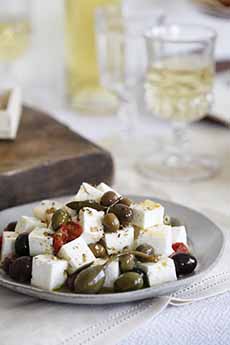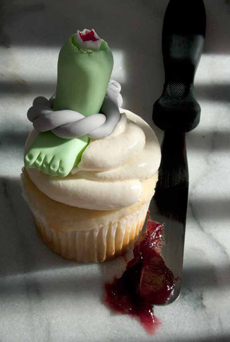|

[1] A glass of Sauvignon Blanc wine with a side of feta and olives (photo © Vermont Creamery).

[2] A Greek salad with Rose wine (photo © Loes Klinker | Unsplash).

[3] Try any of the wines with a spinach and feta flatbread or pizza. Here’s the recipe (photo © King Arthur Flour).

[4] Want to try Greek wines? Look for the Boutari label (photo © Boutari Wineery).
|
|
Feta is Greece’s most famous cheese: a pure white, aged curd cheese that crumbles easily.
While the cheese has been made since antiquity, the name came into the Greek language in the 17th century, from the Italian word fetta, meaning slice.
The name refers to slicing the cheese from the brick.
Authentic feta is a sheep’s milk cheese, or a mixture of sheep’s and goat’s milks.
Outside of the EU, where the recipe is protected by law, it can also be made of cow’s milk.
Feta is formed into bricks and salted and cured for several months in a brine solution.
The cheese is semi-hard, with a flavor that can range from mild and milky to salty with a very tangy acidity.
Watch out: Cheaper brands of feta can be inedibly salty.
If you purchase a brand that turns out to be too salty, soaked the cheese in water or milk to remove some of the saltiness.
If your experience with feta cheese is limited to Greek salads or a pita pocket, branch out: There are many ways to enjoy this tangy cheese.
As we were looking at recipes* on the website of Nikos brand feta, we were inspired by the suggested wine pairings.
FETA CHEESE & WINE PAIRINGS
Of course, the logical place to look for wine pairings is the Greek wine section. But many stores don’t carry them, and most Americans don’t know about them.
So Nikos recommends pairings with familiar wines, that enhance the flavor of feta. If you’re searching for Greek wines, try the Boutari wines.
Beaujolais, a light, fruity red from France
Boutari wines, from a Greek winery that produces more than 15 different Greek varietals
Chardonnay (we suggest steel-fermented rather than aged in new oak)
Grüner Veltliner, a crisp and complex white white wine from Austria (love it!)
Muscat (Moscato, Muscatel), a sweet and fruity white wine now grown around the world, that is thought to be the original grape varietal
Rosé, a “blush wine” made from white grapes that has a pinkish color (the word in French means “pinkish”), which is achieved from allowing the crushed grape juice to remain in contact with the skin for 2-3 days
Sauvignon Blanc, a white wine originally from France, now successfully planted worldwide
Pilsner, a fairly dry, highly-hopped, bottom-fermented lager
Wheat Beer, a beer brewed with a large proportion of wheat, including Hefeweizen, unfiltered wheat beer
White Beer (Wissbier, Witbier), an all-wheat brew
Ouzo, Greece’s signature, anise-flavored apéritif
FETA RECIPES
Best Greek Salad
Fried Feta Cheese With Olives
Mediterranean Tuna Salad With Feta
Mini Greek Salad
Radish & Stone Fruit Salad With Feta
Spanakopita: Greek Spinach Pie
Stuffed Baked Potatoes With Beets & Feta
Watermelon Salad With Feta
Watermelon Salad With Thai Basil & Feta
>>> THE HISTORY OF FETA CHEESE <<<
________________
*Feta and Roasted Eggplant Terrine, Feta Cheese Beggars Pouches, Feta Cheese with White Bean Hummus and more.
|







